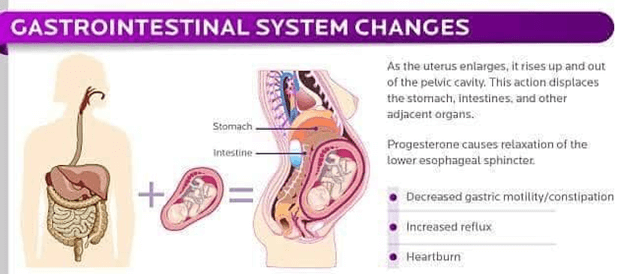Gastrointestinal Changes in pregnancy
- The gastrointestinal system undergoes significant changes to meet the increased nutritional needs of pregnancy and to accommodate the growing uterus.
- The main gastrointestinal changes include:
- Decreased gastric motility: The movement of food through the stomach and intestines slows down during pregnancy. This is due to increased progesterone levels that relax the smooth muscle of the gastrointestinal tract and decrease the tone of the lower esophageal sphincter (the valve that prevents reflux of stomach contents into the esophagus). The gastric motility decreases progressively throughout pregnancy and reaches its lowest point at term.
- Decreased gastric acid secretion: The amount of acid produced by the stomach decreases during pregnancy. This is due to increased progesterone levels that inhibit the secretion of gastrin (the hormone that stimulates acid production) and increase the secretion of bicarbonate (the substance that neutralizes acid). The gastric acid secretion decreases progressively throughout pregnancy and reaches its lowest point at term.
- Increased nausea and vomiting: The sensation of nausea and the act of vomiting increase during pregnancy. This is due to increased human chorionic gonadotropin (hCG) levels that stimulate the vomiting center in the brain and increase the sensitivity to smells, tastes, or sights. The nausea and vomiting peak at 8 to 12 weeks of gestation and then subside by 16 to 20 weeks of gestation. The normal range of nausea and vomiting in pregnancy is less than five episodes per day or less than 5% weight loss.
- Increased appetite and food cravings: The desire to eat and the preference for certain foods increase during pregnancy. This is due to increased metabolic rate, increased nutritional needs, and hormonal fluctuations that affect the taste buds and olfactory receptors. The appetite and food cravings vary throughout pregnancy and may differ among individuals. The normal range of appetite and food cravings in pregnancy is based on the individual’s pre-pregnancy weight, height, and activity level.
- Increased constipation and hemorrhoids: The difficulty in passing stool and the swelling of the veins in the anus increase during pregnancy. This is due to decreased gastric motility, increased progesterone levels, increased pressure of the gravid uterus on the rectum, and increased iron intake. The constipation and hemorrhoids peak at late pregnancy and then improve by the postpartum period. The normal range of constipation and hemorrhoids in pregnancy is less than three bowel movements per week or less than 2+ on grading scale.
- Increased gallbladder dysfunction: The function of the gallbladder (the organ that stores and releases bile) decreases during pregnancy. This is due to increased progesterone levels that decrease the contractility of the gallbladder and increase the cholesterol content of the bile. The gallbladder dysfunction peaks at late pregnancy and then resolves by the postpartum period. The normal range of gallbladder dysfunction in pregnancy is asymptomatic or mild symptoms such as bloating, indigestion, or right upper quadrant pain.
- The gastrointestinal changes result in increased nutrient absorption (the process by which nutrients are taken up from the food into the blood) and decreased gastric emptying (the time it takes for food to leave the stomach) that meet the increased nutritional needs of pregnancy and accommodate the growing uterus
- The gastrointestinal changes may cause symptoms such as heartburn, flatulence, belching, or diarrhea that are normal or abnormal depending on the severity, duration, and frequency

Nursing Test Bank
Quiz #1: RN Exams Pharmacology Exams
Quiz #2: RN Exams Medical-Surgical Exams
Quiz #3: RN Exams Fundamentals Exams
Quiz #4: RN Exams Maternal-Newborn Exams
Quiz #5: RN Exams Anatomy and Physiology Exams
Quiz #6: RN Exams Obstetrics and Pediatrics Exams
Quiz #7: RN Exams Fluid and Electrolytes Exams
Quiz #8: RN Exams Community Health Exams
Quiz #9: RN Exams Promoting Health across the lifespan Exams
Quiz #10: RN Exams Multidimensional care Exams
Naxlex Comprehensive Predictor Exams
Quiz #1: Naxlex RN Comprehensive online practice 2019 B with NGN
Quiz #2: Naxlex RN Comprehensive Predictor 2023
Quiz #3: Naxlex RN Comprehensive Predictor 2023 Exit Exam A
Quiz #4: Naxlex HESI Exit LPN Exam
Quiz #5: Naxlex PN Comprehensive Predictor PN 2020
Quiz #6: Naxlex VATI PN Comprehensive Predictor 2020
Quiz #8: Naxlex PN Comprehensive Predictor 2023 - Exam 1
Quiz #10: Naxlex HESI PN Exit exam
Quiz #11: Naxlex HESI PN EXIT Exam 2
Questions on Gastrointestinal Changes in pregnancy
Correct Answer is A
Explanation
Because progesterone does not increase intestinal absorption. In fact, progesterone may decrease intestinal absorption by reducing intestinal blood flow and slowing down transit time.
Correct Answer is A
Explanation
Decreased bile production is not a factor in nausea and vomiting in pregnancy, but rather a possible cause of gallstones, which are more common in pregnant women due to hormonal changes and increased cholesterol levels.
Correct Answer is A
Explanation
Avoiding physical activity can lead to constipation. Being active helps stool move through the intestines.
Getting regular exercise, with a doctor’s approval, can help relieve constipation. If exercising is not possible, try to fit in a gentle walk each day.
Rice is wrong because rice is a bland and starchy food that can help absorb excess stomach acid and prevent heartburn.
Hyponatremia is not a common complication of HG. Hyponatremia may occur in severe cases of dehydration or if excessive intravenous fluids are given without adequate sodium replacement.
Search Here
Related Topics
- Hypoglycemia - Physiological And Physical Changes In Pregnancy
- Preterm birth - Physiological And Physical Changes In Pregnancy
- Macrosomia - Physiological And Physical Changes In Pregnancy
- Post-term birth - Physiological And Physical Changes In Pregnancy
- Hyperbilirubinemia - Physiological And Physical Changes In Pregnancy
- Cardiovascular Changes in Pregnancy - Physiological And Physical Changes In Pregnancy
More on Nursing
Free Nursing Study Materials
Access to all study guides and practice questions for nursing for free.
- Free Nursing Study Trials
- Free Nursing Video tutorials
- Free Nursing Practice Tests
- Free Exam and Study Modes
- Free Nursing Revision Quizlets
